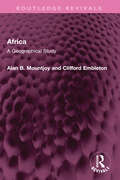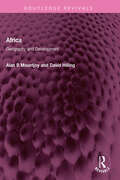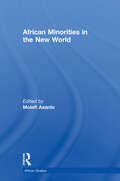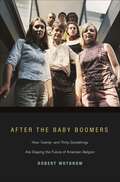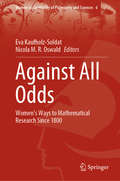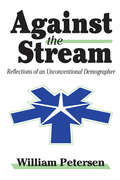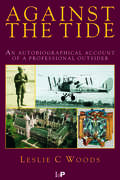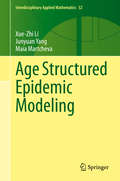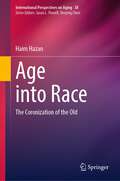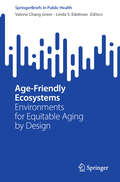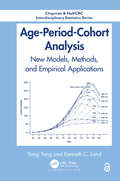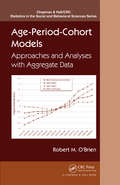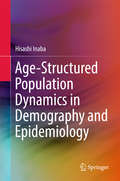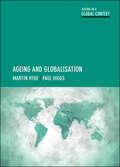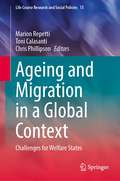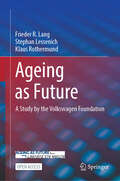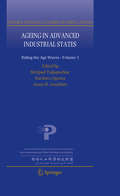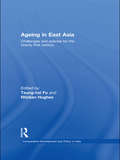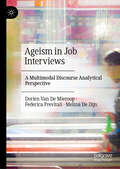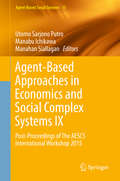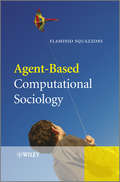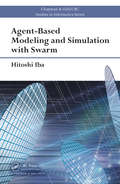- Table View
- List View
Africa: A Geographical Study (Routledge Revivals)
by Clifford Embleton Alan B MountjoyFirst published in 1965, Africa provides a geographical, political, economic and social description of the continent. Contemporary Africa is a continent of change and revolutions. The diversity and limitations of the African environment gives us a fuller understanding of the explosive dynamism of the African economic and social scene. This book will be of interest to students of geography, economy, anthropology and political science.
Africa: Geography and Development (Routledge Revivals)
by David Hilling Alan B MountjoyFirst published in 1988, Africa examines the varied pattern of development in the continent, the progress and the disappointments experienced, and the prospects. This picture is set firmly within the frame of the continent’s geography. From a general synthesis, the books moves to a country by country analysis of the interdependence of geography and economic development. The authors’ analysis of the effects of varied development strategies in Africa leads them, in the final section, to discuss what lessons maybe learned from these earlier initiatives and to assess the changes in development policies that were later implemented. This book will be of interest to students of geography, economics and development studies.
African Minorities in the New World (African Studies)
by Toyin Falola Niyi AfolabiThis book uncovers the reality that new African immigrants now represent a significant force in the configuration of American polity and identity especially in the last forty years. Despite their minority status, African immigrants are making their marks in various areas of human endeavor and accomplishments—from academic, to business, to even scientific inventions. The demographic shift is both welcome news as well as a matter for concern given the consequences of displacement and the paradoxes of exile in the new location. By its very connection to the ‘Old African Diaspora,’ the notion of a ‘New African Diaspora’ marks a clear indication of a historical progression reconnecting continental Africa with the New World without the stigma of slavery. Yet, the notion of trans-Atlantic slavery is never erased when the African diaspora is mentioned whether in the old or new world. Within this paradoxical dispensation, the new African diaspora must be conceived as the aftermath of a global migration crisis.
After Work Balance: Die Perspektiven der Älteren (essentials)
by Dietmar GoldammerWir werden immer älter, und viele Menschen sind beim Eintritt in den Ruhestand noch fit und möchten eine Tätigkeit ausüben, die ihnen Freude bereitet und für andere Nutzen stiftet. Dietmar Goldammer klärt auf, regt an und mobilisiert. Unterschiedliche individuelle Voraussetzungen erfordern unterschiedliche Strategien für eine veränderte Lebenssituation der älteren Menschen, und der Autor informiert mit zahlreichen Beispielen darüber, wie andere diese Situation erfolgreich gelöst haben. Zuvor stellt er dar, wie man sich auf den Ruhestand vorbereiten kann, welche Möglichkeiten es gibt und worauf man achten sollte. Auf diese Weise wird deutlich, dass man auch nach der Pensionierung noch erstrebenswerte Ziele erreichen kann.
After the Baby Boomers: How Twenty- and Thirty-Somethings Are Shaping the Future of American Religion
by Robert WuthnowMuch has been written about the profound impact the post-World War II baby boomers had on American religion. But the lifestyles and beliefs of the generation that has followed--and the influence these younger Americans in their twenties and thirties are having on the face of religion--are not so well understood. It is this next wave of post-boomers that Robert Wuthnow examines in this illuminating book. What are their churchgoing habits and spiritual interests and needs? How does their faith affect their families, their communities, and their politics? Interpreting new evidence from scores of in-depth interviews and surveys, Wuthnow reveals a generation of younger adults who, unlike the baby boomers that preceded them, are taking their time establishing themselves in careers, getting married, starting families of their own, and settling down--resulting in an estimated six million fewer regular churchgoers. He shows how the recent growth in evangelicalism is tapering off, and traces how biblical literalism, while still popular, is becoming less dogmatic and more preoccupied with practical guidance. At the same time, Wuthnow explains how conflicts between religious liberals and conservatives continue--including among new immigrant groups such as Hispanics and Asians--and how in the absence of institutional support many post-boomers have taken a more individualistic, improvised approach to spirituality. Wuthnow's fascinating analysis also explores the impacts of the Internet and so-called virtual churches, and the appeal of megachurches. After the Baby Boomers offers us a tantalizing look at the future of American religion for decades to come.
Again, Essie? (Storytelling Math)
by Jenny LacikaCelebrate diversity, math, and the power of storytelling!Rafael wants to protect his toys from his little sister, Essie. Gathering materials from around the house, he builds a wall tall enough and wide enough to keep her out. But will it be strong enough? And what does Essie really want? A playful exploration of physical space and geometry, featuring Chicanx (Mexican American) characters and a glossary of Spanish words.Storytelling Math celebrates children using math in their daily adventures as they play, build, and discover the world around them. Joyful stories and hands-on activities make it easy for kids and their grown-ups to explore everyday math together. Developed in collaboration with math experts at STEM education nonprofit TERC, under a grant from the Heising-Simons Foundation.
Against All Odds: Women’s Ways to Mathematical Research Since 1800 (Women in the History of Philosophy and Sciences #6)
by Eva Kaufholz-Soldat Nicola M. R. OswaldThis book presents an overview of the ways in which women have been able to conduct mathematical research since the 18th century, despite their general exclusion from the sciences. Grouped into four thematic sections, the authors concentrate on well-known figures like Sophie Germain and Grace Chisholm Young, as well as those who have remained unnoticed by historians so far. Among them are Stanisława Nidodym, the first female students at the universities in Prague at the turn of the 20th century, and the first female professors of mathematics in Denmark. Highlighting individual biographies, couples in science, the situation at specific European universities, and sociological factors influencing specific careers from the 18th century to the present, the authors trace female mathematicians’ status as it evolved from singular and anomalous to virtually commonplace.The book also offers insights into the various obstacles women faced when trying to enter perhaps the “most male” discipline of all, and how some of them continue to shape young girls’ self-perceptions and career choices today. Thus, it will benefit scholars and students in STEM disciplines, gender studies and the history of science; women in science, mathematics and at institutions, and those working in mathematics education.
Against the Stream: Reflections of an Unconventional Demographer
by William PetersenWith the insight and clarity that mark all of Petersen's writings, Against the Stream brings together reflections of an unconventional demographer. Thirteen essays on various topics become a cohesive unit by virtue of the author's unique point of view, and the understanding of contemporary events he has gathered in his long mastery of demography is evident in this volume.In a brief introduction the author points out that the viewpoints he expresses in the volume are unorthodox. He covers a variety of topics. Chapter 1 examines utopian thought, which Petersen notes usually gets good press that, in his view, is undeserved. Chapter 2 discusses planned communities and suburbanization, beginning with two famous utopias presented in books by Edward Bellamy and Ebenezer Howard, which had significant influence on American and British societies. Chapter 3 analyzes the perennial topic of how the balance between people and their sustenance will evolve. Chapter 4 critically explores Durkheim's analysis of suicide. Chapters 5 and 6 analyze the culture, language, and geographical positions of the individual countries of Belguim and Canada, providing a fresh outlook on these routine topics. Chapters 7 and 8 evaluate rebellious Berkeley students and adolescent student rebels in general as the juvenile delinquents that they often are. Chapter 9 discusses the anti-urban bias of the mainline American Churches. Chapter 10 traces the historical roots of Christian holidays, pointing out their significant links with prior religions. Chapter 11 critically examines the history of the English language as a guide to current usage. Chapters 12 and 13 survey two widely misunderstood demographic topics the cause of death and obesity and provide some stimulating new ideas.This latest work by a distinguished demographer is a tightly knit, compact volume, a compendium of thought written in a nontechnical manner and about various subjects that will both interest the general
Against the Tide: An Autobiographical Account of a Professional Outsider
by L.C WoodsIn Against the Tide: An Autobiographical Account of a Professional Outsider, Leslie Woods relates the fascinating story of his life from fisherman's son in New Zealand to head of the Mathematical Institute at the University of Oxford. After starting at a trade school, he won a scholarship to a university, then joined the RNZAF, and later became a fighter pilot in the Pacific. Following WWII, Woods won a Rhodes scholarship to Merton College in Oxford. He has held positions at the University of New South Wales, Oxford's Balliol College, and Culham Laboratory. Besides recounting his history, Woods explains why magnetic fusion has failed to succeed and outlines the philosophy of science to which he subscribes.
Age Structured Epidemic Modeling (Interdisciplinary Applied Mathematics #52)
by Maia Martcheva Xue-Zhi Li Junyuan YangThis book introduces advanced mathematical methods and techniques for analysis and simulation of models in mathematical epidemiology. Chronological age and class-age play an important role in the description of infectious diseases and this text provides the tools for the analysis of this type of partial differential equation models. This book presents general theoretical tools as well as large number of specific examples to guide the reader to develop their own tools that they may then apply to study structured models in mathematical epidemiology. The book will be a valuable addition to the arsenal of all researchers interested in developing theory or studying specific models with age structure.
Age into Race: The Coronization of the Old (International Perspectives on Aging #38)
by Haim HazanAge into Race is a socio-anthropological essay on the repercussions of the Covid-19 pandemic on the cultural status of the old. As the worldwide horrors of the Corona era have since been publicly repressed, the text is geared to revisit and relive the tenor of that time while considering its latent revolutionary aftermath. There was wide agreement that Covid-19 policies targeted older people as a risk group in need of protection, setting it apart from the rest of society. Yet, paradoxically, long-term facilities for older people effectively became Covid-19 death traps. What kind of abandonment propelled this apparent contradiction? This book provides an answer by looking at ageist practices regarding Covid-19 triaging, lockdowns and distancing that affected older people around the world, devising Covid-19 as an inevitable "problem of the elderly" and, by implication, instating and categorizing "the elderly" as a public problem to be bio-politically managed and wrought. The Covid-19 pandemic and its concomitant "state of emergency" triggered an accelerated transmutation of customary ageism into emergent racism, spelling a fatal switch to designating the old as bearers of "bare" life unworthy of human living, thus turning old age from a seemingly cultural category to a socially fabricated viral menace of nature. The book tracks down the process through which the "Coronization" of culture legitimized and impelled a further stigmatization of old age beyond mere ageism to sheer racism. Thus, this transmutation, while compromising their autonomy and subjectivity via imposed lockdowns, social isolation, excommunication and selective discrimination rendered the old a race apart. Subsequently, the moral panic invoked by the specter of the pandemic transformed the social perceptions of later life from a containable social problem to an unbridled public hazard that summoned total measures presented as bureaucratically regimented regulations that dehumanized its victims with impunity.
Age-Friendly Ecosystems: Environments for Equitable Aging by Design (SpringerBriefs in Public Health)
by Valerie Chang Greer Linda S. EdelmanThis compact book examines age friendliness within the framework of age-friendly ecosystems, and from a place-based approach, considering anchor institutions of neighborhoods, campuses and health environments as sites uniquely positioned to catalyze age equity and inclusivity. Age friendliness has grown from an idea into a social movement that recognizes the diversity of older adults, and integrates research, policy, programming and design practices. Compounding pressures of rapid aging, systemic ageism, and a growing disparity of resources compel us to rethink how we achieve equity in aging through the design of places and practices. Content for this book draws from a 2022 symposium, Age Friendly Communities as Platforms for Equity, Health & Wellness. Contributors build upon the content shared through the symposium in order to examine how neighborhoods, campuses and health environments are uniquely poised to support equity and to extend reach to historically marginalized populations of older adults. Ideas and experiences from national experts in aging, as well as "real world" experiences and narratives shared by older adults, students, community stakeholders and faculty researchers, are presented through a place-based approach. Collectively the voices in this book create a lens for empowering age-friendly ecosystems as environments for equitable aging by design. Among the topics covered: Creating an Age-Friendly Environment Across the Ecosystem Age Friendliness as a Framework for Equity in Aging Age-Friendly Voices in the Pursuit of an Age-Friendly Ecosystem Age-Friendly Futures: Equity by Design Age-Friendly Ecosystems: Environments for Equitable Aging by Design is written for people who are interested in understanding how the age-friendly movement is transforming places we live – community planners, designers, policy makers, aging service providers, academics and citizen activists. This compact volume presents a case of need for age friendliness in places we live, learn and care for our health. Readers with interests in the professional practice areas of aging studies/gerontology, architecture and planning, colleges and universities, community/neighborhood development, health systems, research, and policy will benefit from this brief that examines neighborhoods, campuses, and health environments from interdisciplinary perspectives.
Age-Period-Cohort Analysis: New Models, Methods, and Empirical Applications
by Yang Yang Kenneth C. LandThis book explores the ways in which statistical models, methods, and research designs can be used to open new possibilities for APC analysis. Within a single, consistent HAPC-GLMM statistical modeling framework, the authors synthesize APC models and methods for three research designs: age-by-time period tables of population rates or proportions, repeated cross-section sample surveys, and accelerated longitudinal panel studies. They show how the empirical application of the models to various problems leads to many fascinating findings on how outcome variables develop along the age, period, and cohort dimensions.
Age-Period-Cohort Models: Approaches and Analyses with Aggregate Data (Chapman & Hall/CRC Statistics in the Social and Behavioral Sciences)
by Robert O'BrienThis book presents an introduction to the problems and strategies for modeling age, period, and cohort (APC) effects for aggregate-level data. These strategies include constrained estimation, the use of age and/or period and/or cohort characteristics, estimable functions, variance decomposition, and a new technique called the s-constraint approach. Emphasizing both the geometry and algebra of several APC approaches, the book develops readers' understanding of the statistical issues of APC analysis and shows how common methods are related to each other.
Age-Structured Population Dynamics in Demography and Epidemiology
by Hisashi InabaThis book is the first one in which basic demographic models are rigorously formulated by using modern age-structured population dynamics, extended to study real-world population problems. Age structure is a crucial factor in understanding population phenomena, and the essential ideas in demography and epidemiology cannot be understood without mathematical formulation; therefore, this book gives readers a robust mathematical introduction to human population studies. In the first part of the volume, classical demographic models such as the stable population model and its linear extensions, density-dependent nonlinear models, and pair-formation models are formulated by the McKendrick partial differential equation and are analyzed from a dynamical system point of view. In the second part, mathematical models for infectious diseases spreading at the population level are examined by using nonlinear differential equations and a renewal equation. Since an epidemic can be seen as a nonlinear renewal process of an infected population, this book will provide a natural unification point of view for demography and epidemiology. The well-known epidemic threshold principle is formulated by the basic reproduction number, which is also a most important key index in demography. The author develops a universal theory of the basic reproduction number in heterogeneous environments. By introducing the host age structure, epidemic models are developed into more realistic demographic formulations, which are essentially needed to attack urgent epidemiological control problems in the real world.
Ageing and Globalisation (Ageing in a Global Context)
by Martin Hyde Paul HiggsPopulation ageing and globalisation represent two of the most radical social transformations that have occurred. This book provides, for the first time, an accessible overview of how they interact. Ageing has been conventionally framed within the boundaries of nation states, yet demographic changes, transmigration, financial globalization and the global media have rendered this perspective problematic. This much-needed book is the first to apply theories of globalisation to gerontology, including Appadurai’s theory, allowing readers to understand the implications of growing older in a global age. This comprehensive introduction to globalisation for gerontologists is part of the Ageing in a Global Context series, published in association with the British Society of Gerontology. It will be of particular interest to advanced undergraduate and postgraduate students and academics in this area.
Ageing and Migration in a Global Context: Challenges for Welfare States (Life Course Research and Social Policies #13)
by Chris Phillipson Marion Repetti Toni CalasantiThis book brings together two major trends influencing economic and social life: population ageing on the one side, and migration on the other. Both have assumed increasing importance over the course of the 20th and into the 21st century. The book offers a unique interdisciplinary perspective on the challenges posed by the globalisation of the life course to welfare states’ old age and family policies. Through a variety of case studies, it covers a wide range of migration scenarios: those who migrate in later life; migrants from earlier years who age in place; and old people who hire migrant caregivers. It shows how both local and global economic inequalities intersect to frame interactions between ageing, migration, and family support. Across a wide variety of situations, it highlights that migration can both create risks for older people, but also serve as an answer to ageing-related social, economic, and health risks. The book explores tensions between national and global contexts in experiences of migration across the life course. As such this book offers a fascinating read to scholars, students, practitioners, and policy makers in the fields of aging, migration, life course, and population health.
Ageing as Future: A Study by the Volkswagen Foundation
by Stephan Lessenich Frieder R. Lang Klaus RothermundContemporary societies are aging – but what does that mean? Is this something bad? And can societies age as a whole? By bringing together psychological, gerontological, and sociological findings, this open access book opens up a hitherto unique, multifaceted, and realistic view of the phenomenon of old age and the process of aging. The volume is based on the results of the project “Ageing as Future”, a long-term project network (2007-2021) involving a total of more than 30 scientists worldwide. The focus of the project was threefold: A first issue was concerned with how views on aging influence development in old age; secondly, the project analyzed determinants and consequences of provision for old age; and thirdly, it investigated the different ways in which aging is shaped by managing time in old age. For more than a decade, the authors conducted quantitative and qualitative studies, involving large samples from three different continents. The results show that one-sided views of old age – whether negative stereotypes or positive exaggerations – do not do justice to the complexity of the experience of aging. Based on these results, the authors plead for individual and societal acceptance of the social fact of aging – and for the right to live an autonomous and dignified life in old age just as in other phases of life. Ageing as Future: A study by the Volkswagen Foundation presents findings from a unique large international study that are of interest to aging researchers around the world: academically, socio-politically, practically, and personally. Whether old or young, the book encourages one to question one's own views of aging. When reading this book, it becomes obvious that old age is a highly diverse experience, depending on a host of societal and individual factors.
Ageing in Advanced Industrial States: Riding the Age Waves - Volume 3 (International Studies in Population #8)
by Naohiro Ogawa Anne H. Gauthier Shripad TuljapurkarPopulation growth slowed across the world in the last decades of the 20th century, changing substantially our view of the future. The 21st century is likely to see the end to world population growth and become the century of population aging, marked by low fertility and ever-increasing life expectancy. These trends have prompted many to predict a gloomy future caused by an unprecedented economic burden of population aging. In response, industrialized nations will need to implement effective social and economic policies and programs. This is the final volume in a series of three. The papers included explore many examples and strengthen the basis for effective economic and social policies by investigating the economic, social, and demographic consequences of the transformations in the structures of population and family. These consequences include changes in economic behavior, both in labor and financial markets, and with regard to saving and consumption, and intergenerational transfers of money and care.
Ageing in East Asia: Challenges and Policies for the Twenty-First Century (Comparative Development and Policy in Asia)
by Rhidian Hughes Tsung-Hsi FuAgeing populations present considerable challenges to welfare states internationally, and East Asia is no exception. Demographics show that countries in East Asia either have the highest proportion of older people, or the speed at which their population is ageing is faster than anywhere else in the world. This book explores the causes and trends of population ageing in eight countries, and discusses the challenges and impacts of population ageing on public policies. East Asian countries have developed new policies to meet older people’s needs – across health, social care, income maintenance, employment and housing. Ageing in East Asia provides the first comprehensive introduction to ageing policies in East Asian countries. The book: explores causes and trends of population ageing discusses the challenges and impacts of population ageing on public policies examines the important strategic and theoretical policy contexts of ageing policies in East Asian countries covers eight East Asian countries in dedicated chapters: examining Japan, China, South Korea, Taiwan, Hong Kong, Singapore, Malaysia and Thailand. This volume brings East Asian countries clearly into focus, and illuminates the state of welfare development internationally. It provides an important resource for lecturers, students, researchers and policy makers with interest in East Asia, older people and welfare policy.
Ageing in a Nursing Home: Foundations for Care
by Rosalie HudsonSpending the final chapter of your life in a nursing home is considered, by many, a fate worse than death. Others, however, have found that through enlightened, imaginative care even the frailest of lives can flourish. The key to such a transformation is to replace the constricting custodial centres of the past with a more informed, research-based approach. This book is timely, responding to evidence of the urgent need for change described in the Australian Royal Commission into Aged Care Quality and Safety Final Report: Care, Dignity and Respect and its predecessor subtitled Neglect. In this book, the author proposes a model of care that places the whole person at its centre, sidestepping the constraints of a reductionist funding model that focusses on residents' deficits – and the proprietor’s financial gain. Aged care requires a comprehensive research-based guide to fulfil this aim. Narratives are included throughout the book to reinforce the fact that nursing home care is about individual residents and their unique lives. Topics explored in various chapters include:· Ageing in a Changing Community· Social, Gerontological Care· A Palliative Approach· Community Expectations Ageing in a Nursing Home: Foundations for Care takes a realistic approach that draws on contemporary research and narratives from the unique lives of older Australians who, despite their frailty, teach us how to care. Such knowledge informs and influences their future. The book is a resource intended for all who have a stake in the provision of best practice residential aged care, and all who benefit from such care. Its academic appeal will include those who design and teach courses in aged care: gerontology, general practice medicine, nursing, attendant care, allied health, and chaplaincy. Academics and teachers will find useful, well-referenced material for their courses, together with ample scope for researchers.
Ageism in Job Interviews: A Multimodal Discourse Analytical Perspective
by Dorien Van De Mieroop Federica Previtali Melina De DijnThis book investigates age categorizations and stereotyping in job interviews by drawing on a multimodal discourse analytical approach. While previous research on ageism has focused on what happens before or after the job interview, there is substantial evidence supporting the idea that the job interview is a pivotal moment in this respect as well. This is because the way in which the interaction unfolds significantly influences not only recruiters’ ultimate hiring decisions, but also candidates’ interest in pursuing the job offer further. This phase in the recruitment process is thus deserving of further scrutiny when it comes to ageism. The authors delve into age stereotypes regarding ‘old’ as well as ‘young’ age and tease out how they are ‘talked into being’ during job interviews, both by recruiters and candidates. By shedding light on the discursive dynamics of age-based prejudice, stereotyping and discrimination, this books thus aims to further understanding regarding how ageism actually plays out in in real life job interview interactions. The book will be of interest to academics working in fields including interactional sociolinguistics, pragmatics, diversity studies, human resource management and discursive psychology.
Agent-Based Approaches in Economics and Social Complex Systems IX: Post-Proceedings of The AESCS International Workshop 2015 (Agent-Based Social Systems #15)
by Utomo Sarjono Putro Manabu Ichikawa Manahan SiallaganThis book includes many cases that provide new perspectives in developing agent-based modeling and simulation. The real problems are complex, and sophisticated methodology is needed to handle them. Agent-based modeling and simulation is one methodology that provides a bottom-up experimental approach applicable to social sciences such as economics, management, sociology, and politics as well as some engineering fields dealing with social activities. However, to improve the applicability of agent-based modeling and simulation methods, a new perspective is needed. In this book, that new perspective is developed and utilized to deal with many cases of real-world problems such as the supply chain, land use and land cover, transportation, health, services, economics, and social problems. The cases are selected from papers presented at the Ninth International Workshop on Agent-Based Approaches in Economic and Social Complex Systems held in Bali, Indonesia, in 2015. At the workshop, 29 reviewed full papers were presented, and of those, 16 were selected to be included in this volume.
Agent-Based Computational Sociology
by Flaminio SquazzoniMost of the intriguing social phenomena of our time, such as international terrorism, social inequality, and urban ethnic segregation, are consequences of complex forms of agent interaction that are difficult to observe methodically and experimentally. This book looks at a new research stream that makes use of advanced computer simulation modelling techniques to spotlight agent interaction that allows us to explain the emergence of social patterns. It presents a method to pursue analytical sociology investigations that look at relevant social mechanisms in various empirical situations, such as markets, urban cities, and organisations. This book:Provides a comprehensive introduction to epistemological, theoretical and methodological features of agent-based modelling in sociology through various discussions and examples.Presents the pros and cons of using agent-based models in sociology.Explores agent-based models in combining quantitative and qualitative aspects, and micro- and macro levels of analysis.Looks at how to pose an agent-based research question, identifying the model building blocks, and how to validate simulation results.Features examples of agent-based models that look at crucial sociology issues.Supported by an accompanying website featuring data sets and code for the models included in the book. Agent-Based Computational Sociology is written in a common sociological language and features examples of models that look at all the traditional explanatory challenges of sociology. Researchers and graduate students involved in the field of agent-based modelling and computer simulation in areas such as social sciences, cognitive sciences and computer sciences will benefit from this book.
Agent-Based Modeling and Simulation with Swarm (Chapman & Hall/CRC Studies in Informatics Series)
by Hitoshi IbaSwarm-based multi-agent simulation leads to better modeling of tasks in biology, engineering, economics, art, and many other areas. It also facilitates an understanding of complicated phenomena that cannot be solved analytically. Agent-Based Modeling and Simulation with Swarm provides the methodology for a multi-agent-based modeling approach that i
